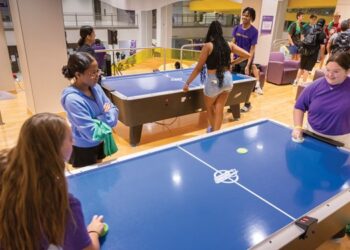At the beginning of the semester, when students step onto Indiana Wesleyan University’s (IWU) campus, they are likely to pass a student wearing a poster about Ultimate around their neck, or see students in flip-flops and cargo shorts playing with a Frisbee on Goodman Lawn.
Being highly visible is how senior Travis Carpenter grew the intramural Ultimate club at IWU.
“We do several things for advertising to get players,” said Carpenter. “We try to get people interested in the club very early on. We don’t try to wait until halfway through the year and pick up players. Literally, from day 1, as soon as students get to the school, that whole first week, we advertise and try to get the word out about the team.”
When Carpenter first came to IWU as a freshman, the university’s Ultimate team had evolved from a club to weekly pick-up games on campus. Wanting to compete competitively, he made it an official club sport at IWU, and began planning for the team to travel for tournaments.
In order to create a team, however, Carpenter needed to make IWU’s students aware that Ultimate existed on campus. He started pick-up games during welcome week and had members of the team wear posters about IWU’s Ultimate club around his or her neck.
Like Carpenter, Gregg DiNardo, the assistant athletic director at Amherst College, also tries to make students aware of intramural sports on campus from the beginning of the semester.
“Specifically, hosting intramural events during orientation because that’s when the new students are excited and eager to learn all about their new school and I’d love to have intramurals be a piece of that right away,” said DiNardo.
This upcoming school year, DiNardo plans to take marketing efforts to the dorms. He is hoping to get the resident counselors to build excitement about intramural sports.
Lynsey Whisner, the director of intramurals at Denison University (DU), consulted IMLeagues.com, an online software for directors of intramural sports, to help her organize, promote and register all intramural sports at the university. With 40 to 45 percent of students participating in club sports at DU, Whisner said the program has not only helped her job, but makes registering easier for the students.
“With all students, everything is revolved around their phone. It really wasn’t difficult [to use],” said Whisner. “They just want to play. They don’t really care about our side of things, which I totally understand.”
DiNardo realized that a lot of marketing comes down to funding, but he said if there is a way to have a giveaway or a contest so students, “actually have some skin in the game,” can capture more attention than a promoted Facebook post or Tweet.
And Carpenter agrees. He encouraged recreation directors to, “think more real than they probably already are.”
“Breaking it all the way down to where would a college student walk?” explained Carpenter. “And what do they see when they look around? And what do they think of when they look around? Rather than just saying, ‘What would a college student like to do?’ I think that’s a little too general, and I think that’s what a lot of people go to when they create ideas for advertising,” said Carpenter.
According to Carpenter, last year 120 students played in the Ultimate pick-up games during the first four days of the semester. In order to promote the sport year-round, he also asked teammates to wear their jerseys on days they had a tournament and even set up a table in the student center with a highlight video of their games. He believes the video helped students see how the sport is played, and could determine if they’re interested enough for more information.










